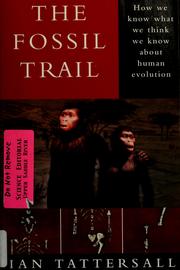Check nearby libraries
Buy this book

One of the most remarkable fossil finds in history occurred in Laetoli, Tanzania, in 1974, when anthropologist Andrew Hill (diving to the ground to avoid a lump of elephant dung thrown by a colleague) came face to face with a set of ancient footprints captured in stone - the earliest recorded steps of our far-off human ancestors, some three million years old.
Today we can see a recreation of the making of the Laetoli footprints at the American Museum of Natural History in a stunning diorama which depicts two of our human forebears walking side by side through a snowy landscape of volcanic ash. But how do we know what these three-million-year-old relatives looked like? How have we reconstructed the eons-long journey from our first ancient steps to where we stand today? In short, how do we know what we think we know about human evolution?
.
In The Fossil Trail, Ian Tattersall, the head of the Anthropology Department at the American Museum of Natural History, takes us on a sweeping tour of the study of human evolution, offering a colorful history of fossil discoveries and a revealing insider's look at how these finds have been interpreted - and misinterpreted - through time. All the major figures and discoveries are here.
We meet Lamarck and Cuvier and Darwin (we learn that Darwin's theory of evolution, though a bombshell, was very congenial to a Victorian ethos of progress), right up to modern theorists such as Niles Eldredge and Stephen Jay Gould. Tattersall describes Dubois's work in Java, the many discoveries in South Africa by pioneers such as Raymond Dart and Robert Broom, Louis and Mary Leakey's work at Olduvai Gorge, Don Johanson's famous discovery of "Lucy" (a 3.4 million-year-old female hominid, some 40% complete), and the more recent discovery of the "Turkana Boy," even more complete than "Lucy" and remarkably similar to modern human skeletons.
He discusses the many techniques available to analyze finds, from fluorine analysis (developed in the 1950s, it exposed Piltdown as a hoax) and radiocarbon dating to such modern techniques as electron spin resonance and the analysis of human mitochondrial DNA. He gives us a succinct picture of what we presently think our family tree looks like, with at least three genera and perhaps a dozen species through time (though he warns that this greatly underestimates the actual diversity of hominids over the past two million or so years). And he paints a vivid, insider's portrait of paleoanthropology, the dogged work in the broiling sun, searching for a tooth or a fractured corner of bone amid stone litter and shadows, with no guarantee of ever finding anything.
And perhaps most important, Tattersall looks at all these great researchers and discoveries within the context of their social and scientific milieu, to reveal the insidious ways that the received wisdom can shape how we interpret fossil findings, that what we expect to find colors our understanding of what we do find.
Refreshingly opinionated and vividly narrated, The Fossil Trail is the only book available to general readers that others a full history of our study of human evolution. A fascinating story with intriguing turns along the way. this well-illustrated volume is essential reading for anyone curious about our human origins.
Check nearby libraries
Buy this book

Previews available in: English
Subjects
Fossil hominids, Human evolution, Paleoanthropology, Prehistoric Anthropology, Mensen, Hominidés fossiles, Paläanthropologie, Hominisation, Évolution, Methodologie, Onderzoek, Evolutie, Paléoanthropologie, Homme, Evolution, Homme fossile, Anthropologie préhistorique, SOCIAL SCIENCE, Anthropology, PhysicalShowing 4 featured editions. View all 4 editions?
| Edition | Availability |
|---|---|
|
1
The fossil trail: how we know what we think we know about human evolution
2009, Oxford University Press
in English
- 2nd ed.
0195367669 9780195367669
|
cccc
Libraries near you:
WorldCat
|
|
2
The Fossil Trail: How We Know What We Think We Know About Human Evolution
December 19, 1996, Oxford University Press, USA
in English
0195109813 9780195109818
|
zzzz
Libraries near you:
WorldCat
|
|
3
The fossil trail: how we know what we think we know about human evolution
1995, Oxford University Press
in English
0585111782 9780585111780
|
aaaa
Libraries near you:
WorldCat
|
|
4
The fossil trail: how we know what we think we know about human evolution
Publisher unknown
0195061012 9780195061017
|
zzzz
Libraries near you:
WorldCat
|
Book Details
Edition Notes
Also available as an electronic book via the World Wide Web to institutions affiliated with netLibrary, Inc.
Includes bibliographical references (p. 249-262) and index.
Classifications
The Physical Object
ID Numbers
Source records
Scriblio MARC recordLibrary of Congress MARC record
Ithaca College Library MARC record
Internet Archive item record
Internet Archive item record
marc_openlibraries_sanfranciscopubliclibrary MARC record
Better World Books record
Library of Congress MARC record
amazon.com record
marc_columbia MARC record
marc_nuls MARC record
marc_columbia MARC record
Community Reviews (0)
Feedback?| July 16, 2024 | Edited by MARC Bot | import existing book |
| January 7, 2023 | Edited by MARC Bot | import existing book |
| August 1, 2020 | Edited by ImportBot | import existing book |
| February 14, 2020 | Edited by MARC Bot | remove fake subjects |
| October 17, 2009 | Created by WorkBot | add works page |















